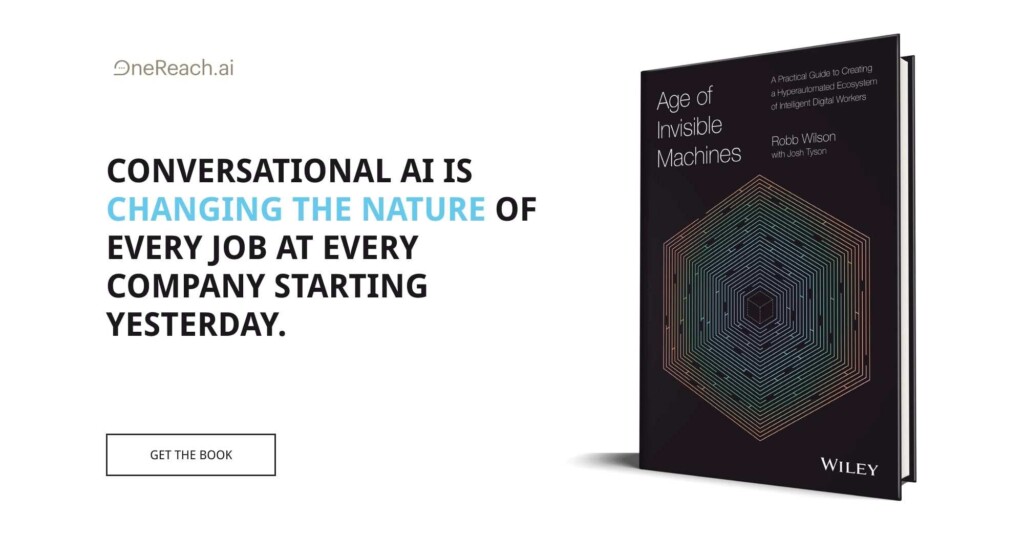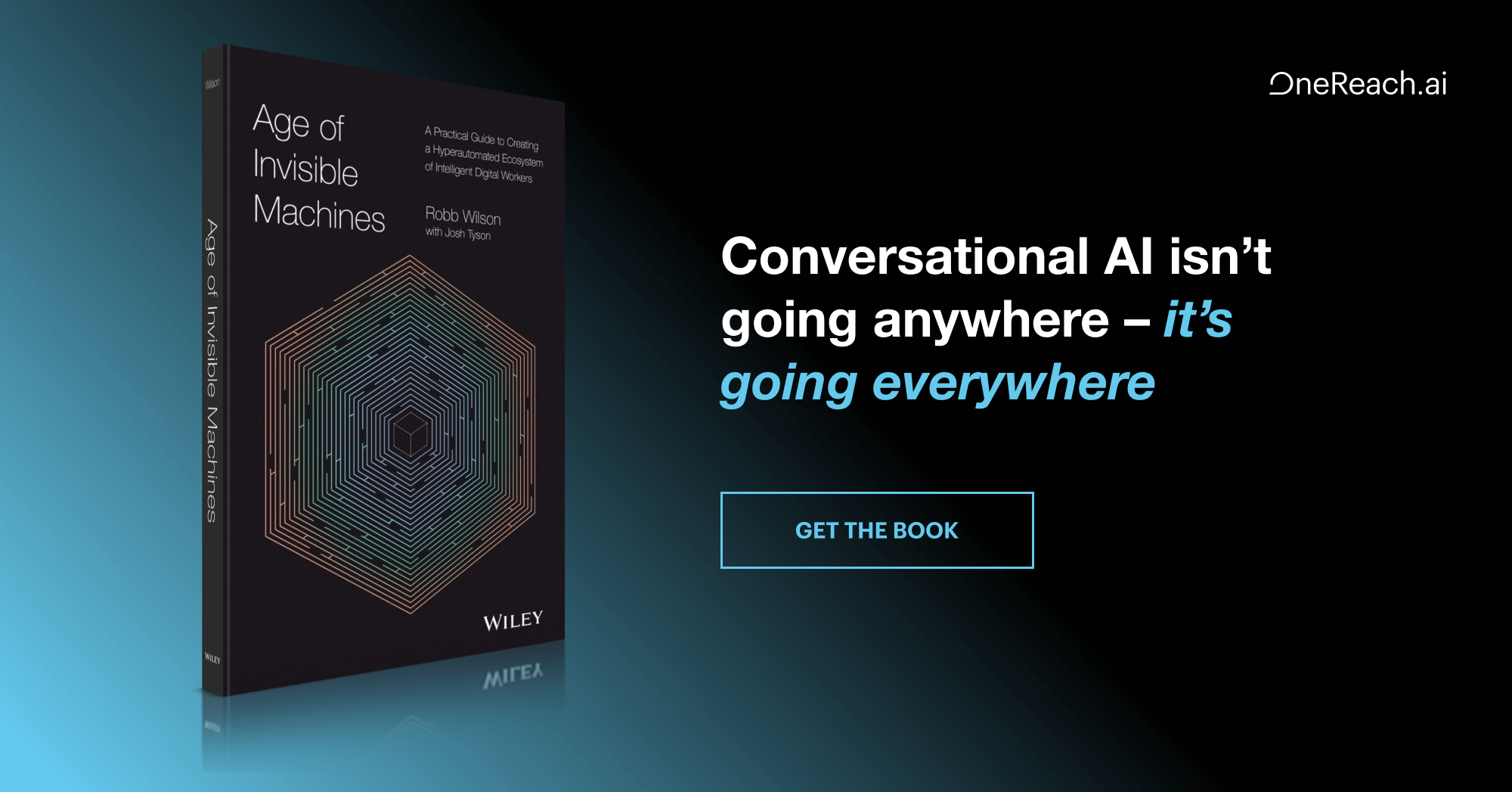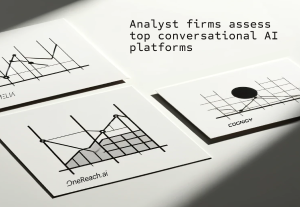With so much noise and hyperbole surrounding today’s race for AI and hyper-automation, choosing a conversational AI platform is a daunting task.
You might be a problem solver at an enterprise aiming to accelerate adoption of AI and conversational technology, a designer looking to create more useful chatbot experiences, or analyst researching tools for iterative, rapid hyper-automation of workflows and business processes. No matter your level of experience or technical background, tools for designing and deploying conversational AI applications are getting easier and better, and some have focused their design around user experience. We took our best shot at evaluating and summarizing the list of top platforms that Gartner Research included in their 2019 Market Guide for Conversational Platforms.
Gartner evaluated over 1,000 platforms and whittled the market down to 20 top platforms in their first year of publishing a Market Guide for Conversational Platforms. The following year, Gartner narrowed their list to 16 platforms, helping buyers to quickly see platforms and tools that stand out from the majority of today’s market of largely “very simple platforms using modified open-source components to deliver simple question and answer chatbots.”
All platforms on their list are noted by Gartner to meet the following criteria:
- Offer an extensible platform for a variety of use cases
- Have above-average capabilities
- Have received client interest via Gartner either through mentions or inquiry
- Show differentiating functionality that is defining for a trend in the market
- Supports cloud deployment, on-premises deployment or both
- Support proprietary NLP, third-party NLP or both
- Support text modalities, voice modalities or both
Gartner turning their microscopes onto conversational AI platforms also seems to officially mark their recognition for how important conversational technology and conversational design have become to staying competitive. We encourage readers to buy and consume Gartner’s Market Guide for Conversational Platforms.
For those of you who don’t want to take the time to review 16 platforms, we’re sharing the findings from our research in a matrix and some deeper breakdowns.
We dug in to give you a general picture of each platform in Gartner’s list, according to criteria that have been useful to readers who are conversational designers, have evaluated conversational AI platforms, or tools for designing and building chatbots, or who have already designed and deployed anything from very basic chatbots to complex, scalable conversational AI experiences.
A small subset of conversational AI platforms on Gartner’s list seem to stand apart from the majority of the list.
Breaking down sixteen conversational AI platforms
We took our best shot at researching the conversational AI platforms in Gartner’s 2019 Market Guide to figure out how each of the sixteen platforms maps to five key criteria.
- Channel Proficiency – what communication channels can you create conversational experiences on?
- Speed – how fast can experiences be designed and deployed?
- Flexibility – what limitations are there for designing and deploying experiences?
- Inclusiveness/Required Expertise – Who can design and deploy conversational AI experiences – what skills and expertise are required?
- “Superbot/Concierge Bot” Readiness – is it relatively easy to design and deploy a superbot, concierge bot, triage bot, masterbot or however you refer to a single conversational bot that’s meant to unify a company’s existing bots through a sort of ‘concierge’ that streamlines or triages to their other bots.
Our evaluations were focused on conversational AI platforms; made up of tools used to simplify the complexity found in bringing together many tools, services, and technologies to create compelling conversational AI experiences. Evaluating these conversational AI platforms is not the same as evaluating natural language understanding solutions or deep learning solutions, which are only a small but important piece of what’s needed to create compelling conversational experiences.
Some conversational platforms offer proprietary natural language understanding (NLU) offerings (like Microsoft, Amazon, Google, etc.), while others let you use any NLU service or multiple at once.
Each of the criteria we evaluated platforms against is described in greater detail below.
How we evaluated platforms
The extent that a platform fulfills any given criterion is indicated by one of five pie symbols (shown below), each representing a degree of fulfillment compared to what is possible in today’s market.
The values assigned for each criterion were determined through our best efforts to interpret publicly available information about each platform (mainly platform websites, documentation, peer reviews, demos, tutorials, videos, etc.); a literature review of sorts.
Executive Summary
Averages by Criteria | Sixteen Platforms At A Glance
The findings from our research are summarized in the table below, where you can see the averages for how the top five performing platforms mapped to our five criteria.
The findings were unexpected:
- Some of the biggest players didn’t show up in the top 5
- We think this happened because deep learning and NLU are only a small piece of the puzzle in creating compelling conversational experiences. The complexity involved in bringing together the many tools, services and technologies required for creating conversational applications covers a broader area than NLU-specific solutions, which is largely what many of the larger brands in the space have invested in.
- For example, a visual reporting layer showing users paths through conversational experiences is automatically deployed for any application created on the OneReach.ai platform, whereas creating the same functionality on Microsoft’s platform, for example, requires loading your data, creating a scheme in SQL Server, then designing a report in Power BI.
- We think this happened because deep learning and NLU are only a small piece of the puzzle in creating compelling conversational experiences. The complexity involved in bringing together the many tools, services and technologies required for creating conversational applications covers a broader area than NLU-specific solutions, which is largely what many of the larger brands in the space have invested in.
- No-code platforms showing up in the top five is surprising
- This is especially surprising given that flexibility was one of just 5 criteria for our evaluations. This suggests platforms are headed in a direction where we won’t have to compromise much on flexibility when building things without coding. Our perspective is that the OneReach.ai Communication Studio has gone way further down this path than most would have expected.
- The leading platform from our analysis is in a class of its own.
- The OneReach.ai conversational AI platform is in its 2nd generation, which could be how they seem to have accomplished so much, particularly in terms of speed and flexibility for building complex applications without writing code.
- The downside is they’re not as big as companies like Google, IBM, Amazon, Microsoft, etc who have more public information and a larger user base that can be helpful to solving problems, but that’s likely to change as others also discover their platform.
Multiple factors were considered for each criterion. Further below you’ll find breakdowns for each individual category, the factors considered for each, and the values attributed to each factor.
Sixteen platforms by channel proficiency
Why does channel proficiency matter?
Companies that have built conversational applications know channel-optionality is critical. Since businesses are expected to exist where their customers communicate and communication channel preferences often change, it’s worth a fortune to know that you have the option to create conversational experiences for any channel. It’s also huge to be able to easily create experiences that can transition from channel to channel and can facilitate single conversations on multiple channels simultaneously.
Purchasing channel-specific conversational AI platforms (for example, a platform for deploying basic Facebook Messenger applications) can sometimes bring decent short-term gains. For most organizations, this is a direct route to unnecessarily paying for several different platforms at once and inevitably replacing them with a robust, channel-agnostic platform that’s more flexible. As you’ll see, these channel-agnostic platforms do actually exist, and a small subset has made enormous leaps beyond what most of us thought was possible without writing code.
The values assigned for the channel proficiency criteria are based on the channels each platform natively enables you to create conversational applications on (for example, phone, voice, SMS, email, Slack, etc.).
We also did our best to consider how hard is it to set up a channel, on a scale of the empty pie (no native way to operate on a channel) to full pie (easy to operate on a channel and full capabilities can be utilized).

Sixteen platforms by Speed
Speed is a tremendous factor when you’re designing, deploying and iterating on conversational AI experiences.
Speed seems to be generally misunderstood and undervalued by companies, often to a detrimental extent. We learned from our readers at several global brands that often months if not years would pass before realizing the tools they chose (often a mishmash of several platforms on Gartner’s list) were a mismatch for the realities of their company. We heard enough stories about companies being 3 months, 9 months, even 16 months into implementations (many who’d redesigned to failure) when they began testing other platforms on this list and found they could cut their schedule to a fraction of their previous timeline without forfeiting the flexibility they needed.
It’s important to know what ‘fast’ means for each platform.
We did our best to evaluate each platform against factors that seem to really matter to speed on a practical level. Some of these platforms don’t require coding, which generally means you can be more inclusive of who creates your experiences and build more, faster.
*Complex = Solutions involving more than basic functions such as operating one conversation on multiple communication channels simultaneously, retaining contextual awareness and history while pivoting across communication channels, recognition of alphanumeric characters like email addresses and passwords, alerting a human when your applications fail and providing easy tools for supplementing knowledge-gaps in real-time.
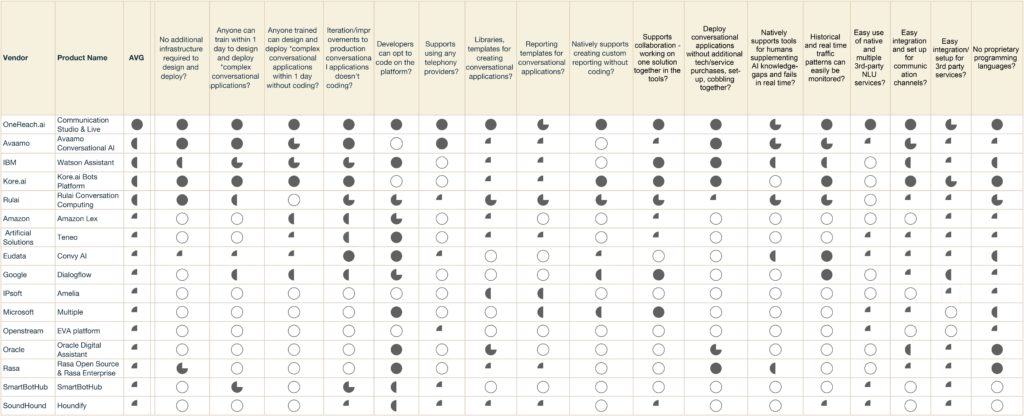
Sixteen platforms by Flexibility
In evaluating for flexibility, we tried to consider how each platform maps to common inflexibilities that often get in the way of designing and implementing sophisticated conversational experiences.
Flexibility regularly makes or breaks conversational initiatives, often in unexpected blows. In one example we learned of a dominant global communications company discovering a devastating impasse with the inflexibility of the conversational platform they were using. They were piloting a voice-based conversational application for customer support when they learned the backend of their deployment would rely on a particular CPaaS provider that is owned by their biggest competitor.
They’d unknowingly invested in using a conversational platform that like many, was inflexible/rigid on which CPaaS could be used for processing voice. The platform also required programming their solution in a proprietary language, which made it pointless to try extracting and transplanting their solution to another platform. They were dead in the water.
There are so many reasons that flexibility is vital. Don’t underestimate it. We did our best to evaluate against particularly useful areas of flexibility.
*Portable’ defined as; source code for conversational applications can be extracted without knowledge of programming languages – for example, to post it in Github.
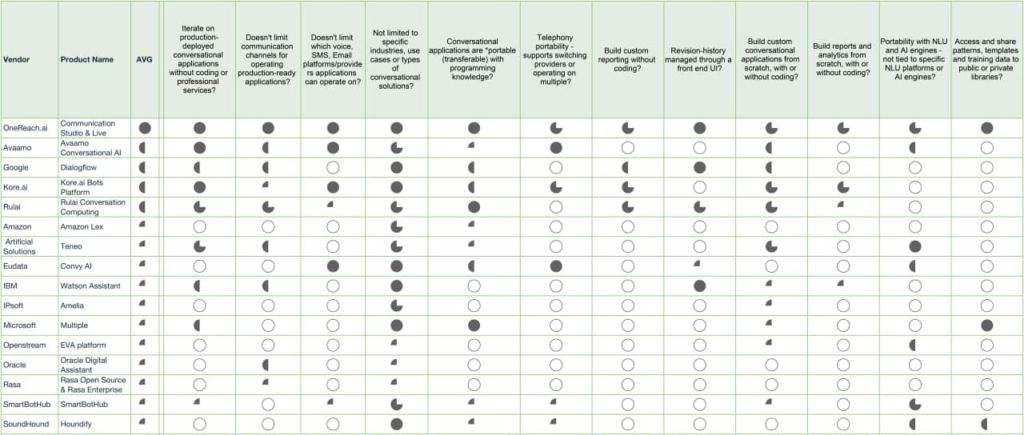
![]()
Sixteen platforms by Inclusivity/Prerequisites
Can you use it? If not you, then who?
This often ends up being an afterthought for many companies. It is critical for companies to understand whether you and your team have the right specialists, skills, expertise and resources for the conversational platforms you’re considering.
Most platforms require you to write code or have software development and network infrastructure resources. Very few conversational AI platforms have truly succeeded at supporting flexible creation of conversational experiences done by designers, business users and other problem solvers who are not software developers.
It’s important to understand who will be able to create and deploy your solutions on the conversational platform you choose. The prerequisite skills and expertise needed for creating compelling experiences will determine who influences and collaborates on the experiences your company creates.
The success of your conversational applications will ultimately be decided by adoption, and adoption requires well designed and useful experiences. Today we know that successful solutions are more likely through problem solvers with diverse perspectives and experiences working together. Fostering inclusivity for who can create and deploy conversational experiences seems to be a significant success factor.

![]()
Sixteen platforms by “Superbot/Concierge Bot” Readiness
* Addendum: As a necessary update to this article, a new criteria has quickly become important to many people at companies that have already implemented a variety of chatbots, conversational applications, AI or workflow automation.
Our aim for this criterion was to consider the relative ease platforms provide in designing and deploying a single conversational bot that’s meant to unify a company’s existing bots through a sort of ‘concierge’ that streamlines or triages to their other already existing bots. We’ve heard such solutions referred to as superbots, concierge bots, triage bots, masterbots – there are probably other names for this rising trend.
This type of solution is a relatively new arrival on the scene. It comes as no surprise that in a race to adopt AI and conversational technologies, companies are moving as quickly as they can. With the rise of citizen developers, and a whole new era of sophisticated code-free tools blowing open the gates on who can design and build conversational applications, it’s easy to see how various people and groups within the same company end up designing and creating uncoordinated chatbots and conversational experiences – often each created using different tools, platforms or point solutions. We’ve heard from readers at companies experiencing these kinds of significant challenges that seem to come from a lack of oversight or a unifying strategy, processes, policies or guidelines. It’s easy to imagine why this quickly becomes painful to companies.
“Superbot”, “concierge bot” or whatever you call it, a single bot that’s a sort of concierge for streamlining to all of an organization’s existing bots is thought to quell the pain organizations face if/when they find themselves having an assortment of otherwise uncoordinated, disparate and often undiscoverable chatbots, etc. In its most basic form, creating this kind of solution enables a company with a sort of triaging bot that sends people to whichever one of their existing bots is supposed to be able to help with an end-user’s query or task. Such a solution is at the very least thought to help companies that are already in up to their waist to buy necessary time for putting together a unifying strategy, guidelines, process, and platform for their company to proceed in a scalable, secure, coordinated, and altogether more strategic way.
Creating such a solution is no small undertaking, and very few of the platforms in this breakdown enable you to build one with ease.
The important criteria to evaluate for in this category are 1) if you have the ability to create this kind of solution on the platform, and 2) the relative ease in doing so. Since bot-to-bot communication can be complicated, very few of these platforms even allow someone to create them.
As best we can tell, OneReach.ai, Kore.ai, IBM, and Rasa are the only platforms that support this and to varying degrees of relative ease. OneReach.ai seems to be the only platform that allows you to build one without knowledge of coding.
Be warned – creating a “superbot”, “concierge bot”, etc, is thought to be more a band-aid than a solution, to something that merits a strategy. A concierge bot could in some scenarios be a reasonable step and may be part of such a strategy, but without a strategy, it’s no better than if you were to build an index page for a mess of website pages there were built without content strategy, any coordination, brand standards, processes or quality assurance.
Conclusion
As with any developing market, there’s a lot of noise, promises, and exaggerations.
The majority of today’s conversational AI platforms seem to be restricted by technical complexity and limited flexibility. Most companies don’t have conversational design chops yet, which makes it so critical to be able to move technology out of the way, iterate often and partner humans with AI to supplement knowledge and skills for your conversational AI applications as you’re ramping them up.
These platforms really matter.
It is a huge thing to be able to future-proof your decisions as much as possible. Consider how different platforms map to the realities of your company and avoid equipping yourself for certain use-cases. Instead, try your damndest to look down the line and keep yourself open and flexible. Equip your future-self for inevitably changing company needs.
*If you think we missed something or have information that is different from what we found, please contact us at [email protected]



